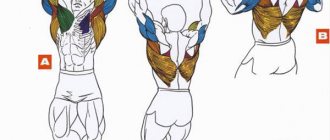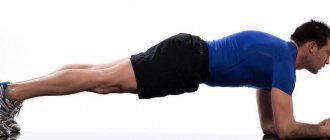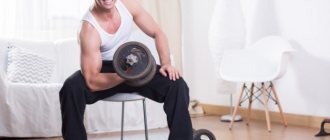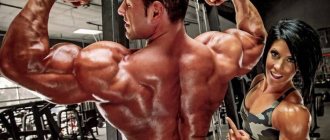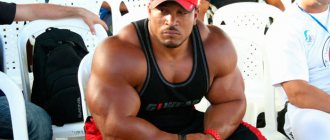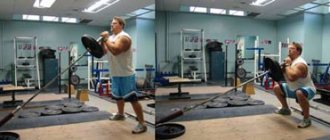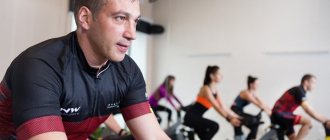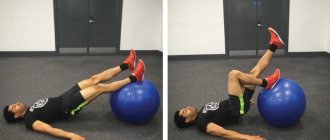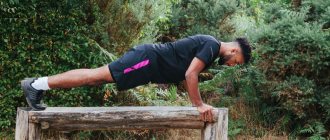Every novice athlete, sooner or later, wonders how to create a training program on their own. To create a competent training program, it is enough to follow simple rules, which will not be difficult to master. It will take much more time to use these rules to choose a truly effective training program that is suitable for you. Since there is no universal program for all occasions, you will have to take time to try different approaches and observe how your body reacts to them.
If we talk in general terms about what the process of strength training is, then we can say that it is a series of constant destruction and restoration. In the process of training, whether training at home or in the gym, we damage muscle fibers. When we sleep, muscle fibers repair and thicken. In this way, our body prepares for less muscle damage next time. In order for muscles to have the opportunity to recover, we must eat properly, providing the body with all the necessary elements.
So, the right training program should provide a good load on the body and sufficient time for muscle recovery after this load. We will achieve the first by doing strength exercises, while the second is achieved by rest after training and proper nutrition. As we can see, a truly effective workout is not just a set of exercises performed in the gym. This is also discipline and adherence to a certain regime, since truly noticeable results can only be achieved by training on an ongoing basis. You will have to change your schedule, build regular workouts into it, rest well, and monitor your diet and diet. Only in this case, after a long time, the result will be noticeable - that very athletic body that you will want not only to show to others, but also to admire it yourself in front of the mirror!
Training process
Training programs - or rather their construction - is a difficult stage for any trainer.
The processes of constructing a training cycle should be divided into:
- Building workouts to gain muscle mass
- Building workouts for weight loss
In any case, the crucial point will be the nutrition factor (calorie surplus or deficit).
Surplus – we spend less energy than we consume.
Deficit – energy consumption is higher than consumption.
The primary role is played by the nutrition process; training may not change at all.
Selecting exercises: sorting by directions
There are a lot of exercises. And if you include various sports equipment in your work, there will be even more of them. When drawing up a program for the week, it is important to clearly determine what format of exercises you need. They are all divided into several categories:
- Aerobic. Otherwise called cardio. Energy is provided through a chemical reaction with glycogen in the presence of oxygen.
- Anaerobic. These are strength exercises. Muscles contract due to the use of creatine phosphate and glycogen, but without the participation of oxygen. As a result, lactic acid is formed.
- Complex. A combination of aerobic and anaerobic exercise.
Interesting fact. In gyms, the emphasis is on strength (anaerobic) training. Exercises are performed using various weights, weights and other equipment. They help build muscle, but are not suitable for weight loss.
If you are planning to lose a couple of extra pounds, then the basis of the program should be aerobic exercise. In a fitness center, the following are suitable for performing them: jump ropes, steppers, exercise bikes, and a treadmill.
Optimal number of workouts per week
The “golden” average for the number of workouts per week will be 3 workouts: for a beginner. Depending on the goals, the training process should be divided into 2 types:
Split – distribution of muscle group training on different days of the cycle/week.
Fullbody is a system that involves working out all muscle groups in one workout.
Monday
# dot the i's #
Monday is a hard day, so it’s worth putting everything in its place, which means we’ll do stretching. Complex stretching will help you mobilize stiff areas of the body and tone the reflex function of the ligamentous apparatus1, which together will help consolidate the correct technique for performing all stages of the cycle. Important bonuses of this type of fitness are also its beneficial effect on the circulatory system, increased muscle strength2 and excellent sleep.
When practicing stretching, special attention should be paid to breathing techniques. Start your workout by breathing deeply for two minutes. As you exhale, try to relax as much as possible.
Stretching the large muscles of the lower extremities
- Perform a heel sit (baby pose, straight at the back).
- Extend your knee joints, lifting your body up.
- Place one of your legs forward, keeping the angle between your thigh and shin close to 90 degrees, and stand on the opposite knee. Keep your upper body straight, resting your hands on your front leg.
- As you exhale, smoothly move your hip area forward, bring yourself to a comfortable tension and fix the position.
- Breathe deeply, and with each subsequent exhalation, try to move your pelvis further forward, overcoming the tension.
- At least 20 breathing acts per side (breathe deeply).
- Try to keep your stomach pulled in throughout the entire exercise.
- When moving forward, keep the angle under the knee of your front leg no sharper than 70 degrees. To adjust, move the sole forward, bringing the projection of the shin relative to the floor closer to the perpendicular.
Target groups: hind leg - quadriceps and sartorius, iliacus; front leg - all muscles of the medial and posterior thigh.
Front thigh stretch
Next, remaining in the same position, we will work deeper on the front surface of the thigh:
- Move the fulcrum of your knee back a little.
- Grab yourself by the toe of your back foot with the same hand, leaving the other on the front as support.
- As you exhale, press your heel to your buttock and fix the position.
- Continue the deep rhythm of breathing, followed by exhalations, pushing the pelvis forward and controlling the tension of the quadriceps.
- At least 15 breathing acts per side (breathe deeply).
- The main stretch of the quadriceps muscle is due to your own grip.
- Control the forward movement of the pelvis, avoiding the reflexive removal of the heel from the buttock.
Stretching the gluteal, gemellus, obturator and piriformis muscles
And again, without changing the starting position, we will engage in the following muscle groups:
- Use the floor as a support point, keeping your forward leg between your hands.
- Straighten your back leg as much as possible.
- Move your front ankle medially until your shin is completely in contact with the floor.
- Feel the stretch in your gluteal muscle.
- As you exhale, smoothly tilt your body forward and fix the position.
- Continue bending rhythmically, and if necessary, lower yourself onto your elbows.
- At least 15 breathing acts per side (breathe deeply).
Target groups: gluteal, gemelli, obturator and piriformis muscles.
Hamstring stretch
Let's move on to the back of the thigh:
- Straighten your front leg, bringing your foot towards you.
- With the same hand, rush towards the toe, using the other as a support.
- With each exhalation, try to grab yourself further by the sole.
- At least 8 breathing acts per side (breathe deeply), then repeat this exercise using opposite upper limbs.
- When doing this, pay attention to the variability in the degree of tension.
- Keep your front leg as straight as possible.
- Try not to round your lower back, but rather move your chest to follow your leading hand.
Target groups: biceps, semitendinosus and semimembranosus muscles.
The first four-part complex, as you may have noticed, we devoted to large muscle fibers located mainly below the hip joint - perhaps the most significant station of human biomechanical messages, which has the greatest impact on the spine, abdominal organs and legs. Each joint has its own subtleties and nuances, which we will discuss in detail in the corresponding selection of articles. For now, let's continue with the basic complex aimed at the upper body.
Neck stretch
On the top floor, the dominant organ is undoubtedly the head, so let’s start with it:
- Bring yourself into a standing position with your feet apart.
- Slowly tilt your head to one side (right or left).
- With the same hand, grab your head and bring the lateral muscles of your neck to a comfortable tension for you.
- Hold the position for 8-10 seconds. in each direction. Repeat 5 times.
- Tilt your head forward.
- Place both hands on the back of your head and stretch the back muscles of your neck.
- Hold the position for 8-10 seconds. Perform at least 4 repetitions.
- Remember to breathe deeply throughout the exercise.
- Notice how the muscles relax as you exhale.
- Don't put too much pressure on your head.
Stretching the deltoid and pectoral muscles
Let's move on to the deltoid and pectoral muscles:
- From a spread-legged stance, place one of your palms on the opposite shoulder.
- With your free hand, grab your elbow and, controlling the tension in the posterior deltoid region, bring the elbow towards your shoulder.
- Hold the position for 15-20 seconds. Perform at least 4 reps per side.
- Go to a doorway or closet in your room.
- Position yourself so that after placing one of your palms on the surface of the support, there is free space for tilting the body forward. Attention! When setting the support, the elbow should be higher than the shoulder and the arm should be straightened.
- As you exhale, bend forward, controlling the tension in your pectoral muscles.
- At the peak of the tension that is comfortable for you, hold the position for 8 seconds.
- Perform at least 6 reps per side. Don't hold your breath!
Stretching the lower back muscles
Let's complete the complex by stretching the lower back muscles:
- In a spread-legged stance, place your feet slightly wider.
- Perform alternating soft bends to the sides, sliding your hands along your legs.
- Bend while exhaling.
- Perform at least 25 bends in each direction.
- Try to keep your stomach pulled in and bend as you exhale.
Target group: quadratus dorsi muscle.
- Place your feet even wider than in the previous exercise.
- Bend over and place one of your palms on the floor in the center.
- Raise your second hand up, forming a straight line with the first.
- Take a deep breath and, as you exhale, return to the starting position with your arm raised up (imagining that you are holding a weight).
- Perform the next inclination again while exhaling, and also with a hypothetical weight (this will allow you to master the technique of this movement as quickly as possible).
- 15 tilts on each side.
Target groups: longissimus, iliocostalis, serratus dorsi inferior.
Repeat the entire complex three to five times, and the first workout is complete! During class, be extremely attentive to yourself and pay attention to the most spasmodic areas of the body. In the future, this will help you develop the ideal execution technique and avoid injuries.
SPLIT style workouts
So, we have 3 workouts per week in our arsenal, how to correctly create a plan (one of the options):
1. Chest and triceps 2. Shoulders and legs 3. Back and biceps
Or this option:
1. Shoulders and legs 2. Chest and biceps 3. Back and triceps
If we train 4 times a week, training schemes can be built as follows:
- Legs
- Chest and triceps
- Back and biceps
- Shoulders (working all 3 beams).
5 day training split:
- Legs
- Breast
- Back
- Shoulders (working all 3 beams)
- Biceps and triceps.
In the case of a 6-day split, you can perform each muscle group on a separate training day.
Want my customized cycle training program? Write through contacts and I will send it to you for free (with the note: I want free training).
A HEALTHY HABIT IS TO RECORD THE RESULT
For greater efficiency, get yourself a useful habit - keep a diary of training and rest every day. Record your future plans and everything that happened to you in it:
- Lay out your training plan from start to finish. Write down the exercises, working weights, number of approaches and repetitions, breaks between exercises, evening jogging. If the training did not go according to plan, record the results you worked out.
- Make a meal plan for the day, counting food in grams, calories, proteins and carbohydrates. Record the amount of fluid you drink per day. Record everything you ate and drank, and calculate the final result. To do this, it is recommended to study nutrition for athletes in more detail, make a list of foods with a low glycemic index and high protein content. Create a blacklist of products.
- Every day, measure the circumference of different parts of the body and weight with a centimeter, and record the numbers in a diary.
- Make notes about how you feel on rest days. If you feel unwell, try to find the cause in yesterday. Perhaps you will see it in the column with the liquid you drink during the day. Record your sleep time.
Once a month, take the time to analyze your notes, highlight the most effective results and vice versa. Thus, an understanding will come about quality training and nutrition. In the meantime, this understanding is not available, check out the recommended workout by day of the week. Learn nutrition for beginner bodybuilders.
Muscle Growth Factors
Progression in loads (mechanical stress);
Metabolic stress;
Microtrauma of muscle fibers.
There is a fourth separate, important factor - the increase in the concentration of anabolic hormones in the blood, the most important of which are testosterone and growth hormone. This fact is precisely related to the popular practice of using steroids in sports.
Your next task will be to be able to combine the above factors.
Wednesday
# interval training - 10 min #
Interval training better stimulates the heart muscle and increases tissue oxygenation4, as confirmed by a recent study from the University of Wales, Swansea, published in The Journal of Sports Science and Medicine.
As an introduction to this type of load, we have chosen a standard burpee for you.
To start, we suggest you follow the 30/30 interval. In the future we will talk about more intensive options. Let's get started.
Burpee
Men:
- Stand up straight.
- Squat down with your hands touching the floor.
- Jump into a prone position.
- Do push-ups from the floor.
- Jump back to the squat position.
- Jump up.
Girls - no push-ups.
- We work for 30 seconds / rest for 30 seconds.
- Try to perform at least 10 jumps per working interval.
- Rest in a standing position (do not lie down or sit).
Thursday
# strength training #
Today we will conduct a light strength training, the main targets of which will be small muscle groups and the abs.
- Reverse chair push-ups.
- Press pendulum.
- Calf raises.
Reverse push-ups from a chair or sofa
- Stand with your back to the chair.
- Sit down with your hands on the edges of the chair behind your back.
- Feel the support.
- Straighten your legs.
- As you exhale, lower your body down.
- As you exhale, push yourself up.
- 4 sets of 15-20 repetitions.
Press pendulum
- Take a supine position.
- Place your arms along your body, palms on the floor.
- Raise your legs, forming a 90-degree angle with your body.
- Alternately lower your legs to the sides, touching the floor with your ankle.
- 4 sets of 16 reps.
- Try not to bend your knees and keep the angle between your stomach and hips close to 90 degrees.
Calf raises
- Place your feet shoulder-width apart. Place your feet parallel.
- Rise up onto your toes, straightening your ankle joints.
- Fix the position at the top point for 1-2 seconds.
- 3 sets of 30 reps.
Features of female physiology
A healthy lifestyle and maintaining a fit body is not only a fashion trend in recent years, but also the right approach to lifestyle in general. A beautiful and fit body is an accessible reality for all girls and men, and desire and constant work on yourself will help you achieve your goal.
When creating a training program for girls, you need to take into account the physiological characteristics of the body. The building of muscle tissue is influenced by hormones - testosterone and norepinephrine. Unlike men, the female body does not have a large content of these hormones, which is why girls do not perform exercises to the point of muscle failure.
Therefore, when performing a strength exercise, you need to gradually increase the number of approaches. Nature has given women the ability to bear children, which is why the female body makes reserves in the form of fat deposits. To create beautiful forms, you need to combine exercise with proper nutrition, which will include daily calorie counting.
You can create a training program for a girl yourself. First, to do this, you need to determine the main points.
Friday
# functional training #
The main benefits of functional training are the development of coordination, agility and mobility.
- Rising from a chair on one leg + abduction.
- Side lunge.
- Bends on one leg.
- Swing your legs in a plank position.
Rising from a chair on one leg + abduction
- Sit down on a chair.
- Straighten one of your legs.
- Get up from the chair and stand back on one leg.
- 12 reps on each leg.
- Use a slight forward lean to initiate the lift.
Side lunge
- From a standing position with your feet apart, take a wide step towards one of your legs.
- Squat down as you inhale and rise up as you exhale.
- Do the same in the other direction.
- 12 reps per side (24).
Bends on one leg
- From the position with your legs apart, inhale and bend over while simultaneously lifting one of your legs and touch your hands to the toe of your supporting leg.
- As you exhale, lift your body to the starting position.
- 12 bends to each leg (24).
Leg swings in plank
- Take a plank position with your arms straight.
- Raise your legs up one at a time, maintaining the plank.
- 15 lifts on each leg (30).
Of course your goal
Every good workout needs to be tailored to your needs, so you need to set yourself realistic goals and plans. The first step is to set your main goal. Of course, we are talking about your motivation , as a result of which you decided to start training. Decide whether you want to increase strength, gain size and muscle, or lose fat. The second step is to decide how you want to achieve this goal . For example, if you want to lose fat, increase the capacity of your workouts. [6]
It's important that you understand that your goal is influenced by how long you train, how many sets you do, and what exercises are right for you. [2] Don't forget that once you've chosen a goal, you'll have to stay there for a while. If you want to achieve muscle growth and eat right and train for 4 weeks , and the next 4 weeks you try to lose fat, then you will never achieve . [5] Choose a realistic goal and stick to it for at least 12 weeks . You will see that there will definitely be changes
Sunday
Day off
Conclusion
The human immune system is a complex coordinated mechanism that creates an obstacle to both external and internal unfavorable agents. Its performance depends on many factors. Each immunity module subtly reacts to the slightest changes and errors in the system for providing certain needs. Evolution has rewarded us with a powerful and virtually fail-safe protection tool that is capable of constantly learning and saving settings for life. Our task is only to properly provide support for this vital function of the body. In order not to reduce the tone of your own immunity, eliminate the risks from exposure to bad habits, eat well and rationally, consume the required amount of fluid and exercise!
Editor and proofreader: Farida Seidova
Are you training at home? Then you might also be interested in these articles:
Workout
4 exercises with an elastic band or expander AT HOME (WITH VIDEO)
You don't need a heavily equipped home gym to get an effective strength training session. All you need to feel the burning sensation in your muscles is an elastic band and good motivation.
2020-04-20 09:10:15 • Isaac Syred
Workout
7 Best Shoulder Exercises AT HOME (WITH VIDEO)
How to pump up your shoulders at home? We present to you effective exercises with your own weight and with dumbbells to develop the deltoid muscles.
2020-03-31 08:13:59 • Grant Koch
Workout
Plyometrics and interval training
The essence of plyometric exercises is to use the maximum number of muscle fibers when performing exercises in the shortest possible time. The essence of interval training is to maximize metabolism by alternating exercises at a high-intensity pace with a short rest or low-intensity load.
- Plyometrics and plyometric training are an effective method of fighting fat
WHO ARE THESE TRAININGS FOR?
Explosive and intense training is suitable for girls who have been involved in sports for a long time and have good physical fitness and endurance. For pregnant girls who also have cardiovascular diseases, knee and back problems, these workouts are contraindicated.
These two types of training:
√ develop muscle strength, speed and endurance;
√ force the body to work almost to the limit of its capabilities, which helps it burn a large number of calories in a short period of time;
√ They use mainly red (fast) muscle fibers, which are responsible not only for muscle strength, but also for muscle relief.
Types of plyometric exercises:
- Squat Jump
- Jumping lunges
- Jumping 180 degrees with a squat
- Burpee
- Plank “legs together and apart”, etc.
Fitness program
A fitness program is a system of exercises aimed at correcting your figure and improving your health.
Below is a list of the most popular programs:
- LESS MILLES . The exercises in this program are performed to rhythmic music, most often using dumbbells. Suitable for everyone who loves active fitness.
- MIND & BODY . The program is aimed at developing flexibility; all exercises are performed to relaxing music. Suitable for all those who do not like intense training.
- BODYBALANCE . The classes combine yoga and Pilates exercises. Develop flexibility, endurance and improve health.
- BODYCOMBAT . _ The program combines various types of martial arts: kickboxing, taekwando, karate. Lesson duration 50 min. Girls with joint problems should consult a doctor before training.
- STRECH . The set of exercises is aimed at improving the condition of the joints and increasing the flexibility of the body. Performing exercises is combined with correct breathing technique. The lesson lasts 1.5 hours. There are no contraindications to this program.
- PILATES MAT . The program will teach you to feel your body, strengthen your spine and tone your muscles. A month of regular exercise will help you acquire a beautiful silhouette and good stretching. Duration of classes is 55 minutes, there are no contraindications for performance.

